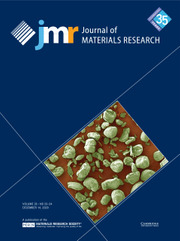Article contents
Accelerated microwave synthesis of magnesium sulfide with the pro-heating medium of graphite
Published online by Cambridge University Press: 03 March 2011
Abstract
Two reaction routes have been tried for the synthesis of magncsium sulfide by applying microwave irradiation. In the first trial, finely ground Mg and S were mixed thoroughly and heated in a microwave oven for various lengths of time (5 + 5 + 8 + 10 and 12 + 12 + 35 + 45 min) in a sealed quartz tube. In the second trial, the pro-heating medium (PHM) of graphite was introduced into the mixture of Mg and S and microwaved for only 1 min. Results of x-ray diffraction analyses of the reaction products indicated that MgS polycrystallites (cubic, a0 = 5.201 ± 0.001) had formed in the second trial, and that the MgS yield was greater than 98%. Data of EDAX and EPMA gave a formula of MgS with atomic ratio of Mg:S = 1.0:1.0. In contrast, MgS could not be identified in the reaction mixtures in the first trial. Obviously, graphite, as a PHM, played a key role in the dramatic enhancement of the rate of the reaction between Mg and S powders. Furthermore, the effect of different molar ratios of graphite to Mg on the rate of microwave synthesis was investigated.
Information
- Type
- Articles
- Information
- Copyright
- Copyright © Materials Research Society 1995
References
REFERENCES
- 10
- Cited by

